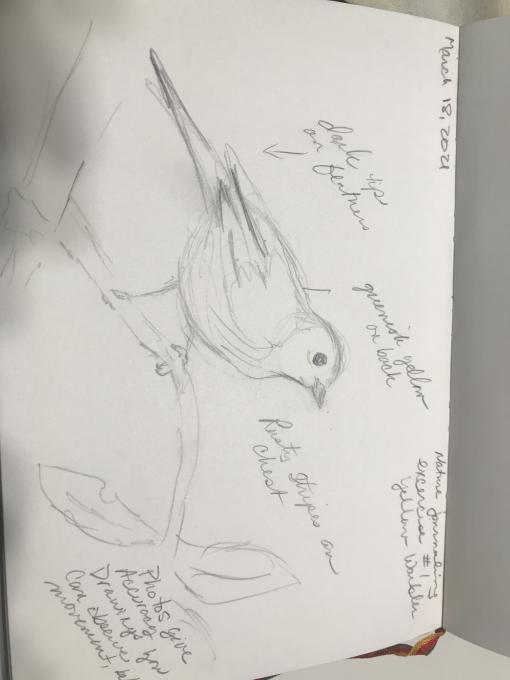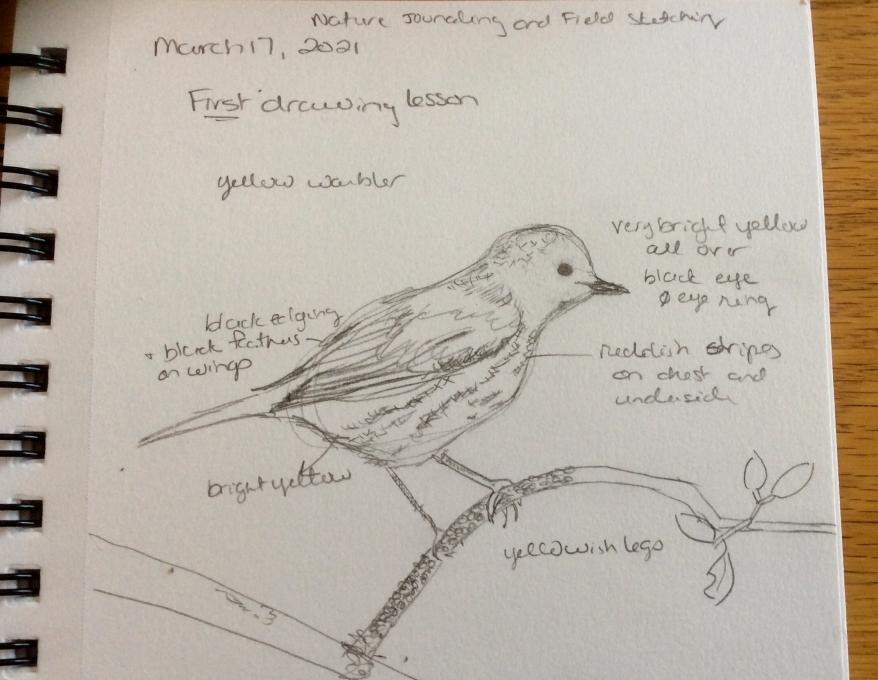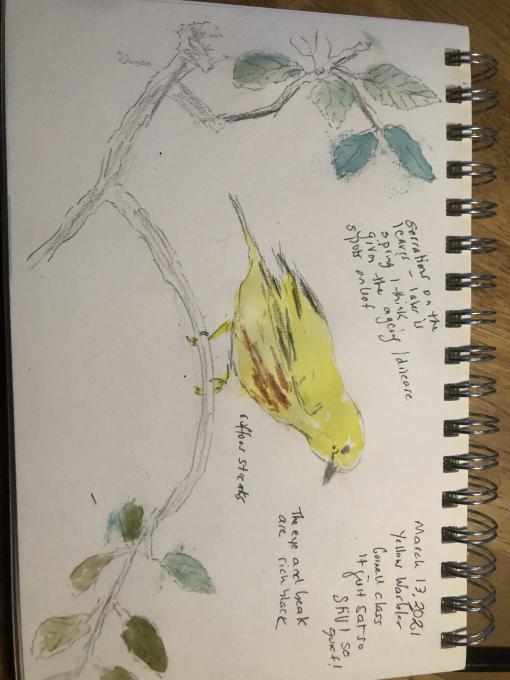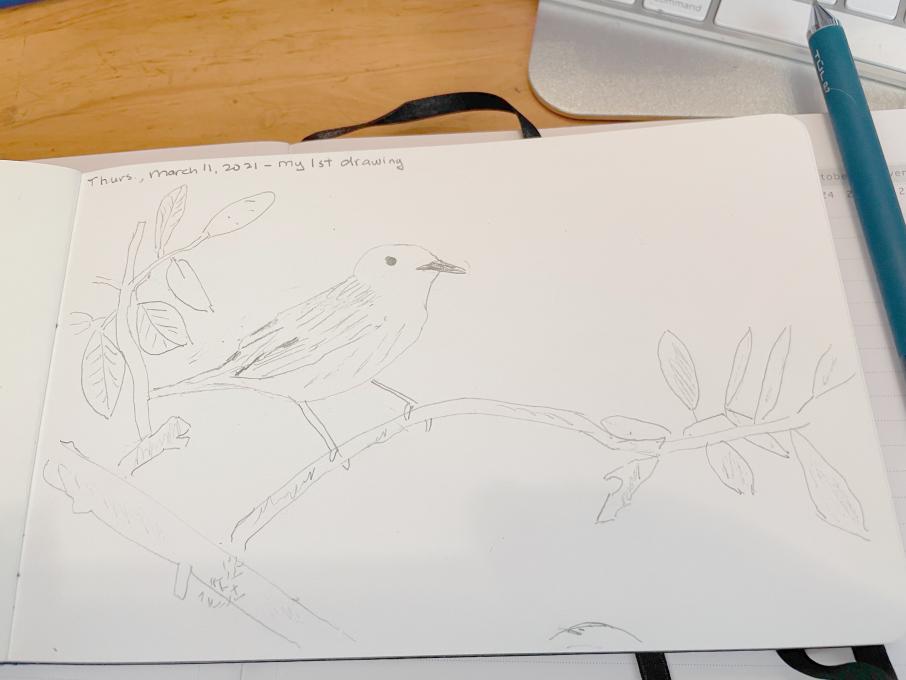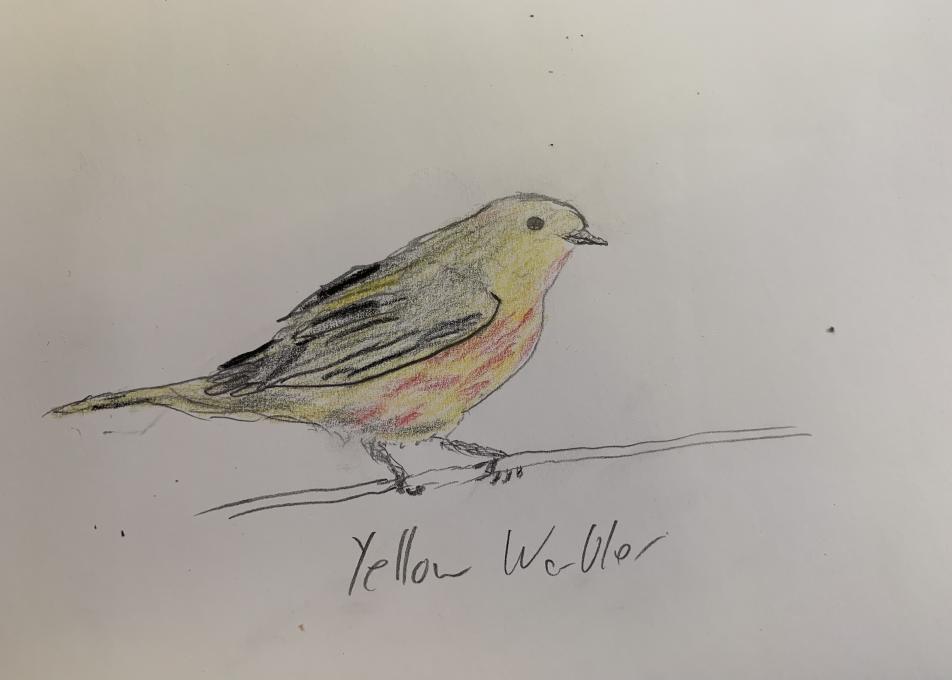The Cornell Lab Bird Academy › Discussion Groups › Nature Journaling and Field Sketching › Jump Right in!
-
What fun! I just grabbed my granddaughter's sketch pad, a pencil and two colored pencils... and forgot about making dinner.
I loved examining the relationship of the wing to the body with the different textures and colors as I tried to draw the little bird. I would not have noticed these components if I had just a photograph to study.
-

-
1. I prefer drawing from photos over real life events. It gives me the opportunity to notice so many little details I would have overlooked.
2. There are so many things I would not have noticed if I wasn't drawing it; the different types of moss/lichen on the branch, the reddish/brown feathers underneath, the perfectly circular eye, the chewed on leaf... I think nature journaling forces you to slow and pay attention to the little things.

-
 It is fun to draw from a photo as I can zoom in for detail and the bird doesn’t move.
It is fun to draw from a photo as I can zoom in for detail and the bird doesn’t move. -
I was surprised that I could draw anything remotely ressembling a bird! Drawing has always intimidated me! Photography is my hobby, but my usual focus (!) is on composing the image, etc., and many of the fine details the bird identification are lost. I like trying to place the eye in relation to the bill, placement of feet, shape of head, etc. It was fun!

-
I’m pleased my drawing looks like a bird! I felt a bit intimidated at the thought of trying to draw anything. At first I was really trying to get the shapes right but once I started focusing on the details I let go of my perfectionism (a little) and just enjoyed noticing and trying to get some of the details. I found the feet to be really tricky!

-
You captured those little feet just beautifully! They caught my attention, too.
-
-
The photo allowed time to really examine the scene.

-
It was difficult to capture the bird's pose - the bird has such an alert, energetic presence. My rendering slopes down too much at the tail. It's dismaying to see the differences between the photo and the drawing but feel as though I have limited ability to bridge the gap. I do enjoy finding the lights and darks in an image and taking note of textures.

-
After taking Liz's Drawn to Birds yesterday, I immediately signed up for this class. It has already been so much fun! Drawing from the photo was definitely easier than drawing from nature. When I try to draw birds at my bird feeder, they shift and fly away so I end up drawing from a field guide. The leaves weren't too difficult, but the overall shape of the bird was challenging. Trying to determine the relative sizes of the head and body was not easy. If I had not been drawing, I probably would not have noticed the lichen, moss, and the reddish color on the bird's breast. When nature journaling, noticing these details will make my drawings so much more realistic.

-

-
I enjoyed this first exercise, especially because it forced me to slow down and to notice details I might have glanced past otherwise. For example, I noticed some of the surrounding leaves had nibbles taken from them, the specific way the warbler's feet wrapped around the branch, and the beautiful patterning on its chest, details I might not have noticed in a photograph. I found it quite difficult to match the shapes, angles, and lines of the warbler, even when I thought I saw them quite well, with my own representation on the page. I did feel okay about how some of the details turned out, but mostly I'm excited to pick up some new tools throughout this course, and to hopefully see some improvement at the end!
-
The most challenging was drawing the bird and trying to get its anatomy correct. I’m not sure I would have noticed all the detail on the branch in the photo or it’s texture from the lichen and moss. Yes. I think noticing more detail does make a difference in nature journaling. One may start out drawing the bird but then notice the detail and decide to place mor emphasis on this detail rather than the bird. Noticing the detail opens up more journaling avenues.
-

Need to learn to use the watercolors.. I like them, but they're a bit messy.
I think photos have an advantage in getting everything recorded at once, so no details are lost. However, the sketching process makes *me* pay attention to the details as I'm drawing them. -

 I think drawings have the advantage of capturing feeling through the eyes and hand of the person drawing - as long as a scientific approach isn't required. Photos have the advantage of capturing actual colors and detail in a clear image. I enjoyed drawing from the photo, because I tend to be slow and might miss a lot of details if I were drawing from nature. I think the overall proportions came easily to me, although there are some areas that are a little off. What was challenging for me was the relationship between the eye and the beak, and capturing the position and definition of the feathers. I might not have noticed all the detail in the branches and feathers if I didn't draw it, and this detail can be important when reporting on your observations in your journal, to differentiate the various birds and their environment.
I think drawings have the advantage of capturing feeling through the eyes and hand of the person drawing - as long as a scientific approach isn't required. Photos have the advantage of capturing actual colors and detail in a clear image. I enjoyed drawing from the photo, because I tend to be slow and might miss a lot of details if I were drawing from nature. I think the overall proportions came easily to me, although there are some areas that are a little off. What was challenging for me was the relationship between the eye and the beak, and capturing the position and definition of the feathers. I might not have noticed all the detail in the branches and feathers if I didn't draw it, and this detail can be important when reporting on your observations in your journal, to differentiate the various birds and their environment. -
1) I felt intimidated at first drawing from the photo, but relaxed when I realized the bird was not going to fly away and that I could take my time. It was challenging to get proportions right and to capture the essence of a living creature. The easiest thing was making observations.
2) I would not have noticed the details on the branches, eg the lichen and mosses. I also would not have been as aware of the subtle colors on the bird and leaves. I think this makes a difference when nature journaling because it exercises observational skills leading to questions, the next drawing, getting lost in the moment, etc.
-
 Photos are quick and easy but one's attention to detail really comes into play when you try to draw/paint it. I kept wondering how much detail do I need to add?
Photos are quick and easy but one's attention to detail really comes into play when you try to draw/paint it. I kept wondering how much detail do I need to add? -
Getting the shape of the warbler was not too difficult but I struggled with the beak. I did notice a slight up angle on the bottom of the beak and how it wraps around the head. Just had a difficult time trying to capture it. I like to do drawings from photos to loosen up and practice shapes. There is less pressure to be quick because your subject isn’t about to fly away!

-
It was a fun sketch to do. I love drawing birds. Drawing the bird was easy, except for its feet... I probably would not have noticed the lichen or the moss on the branches. I would have been focused on the color of the bird and it's markings so I could identify what kind of bird it was. Yes it would make a difference in journaling, because the type of tree and leaves are part of the birds habitat.
-
There is so much I wouldn't have noticed if I didn't draw this yellow warbler, particularly the fine details, like the color of his legs and feet, or the way the the reddish brown is patterned on his breast. I am sure it all makes a difference with nature drawing because so many differences between species are so subtle, that they are important to notice and document, if you really want to learn what you are looking at. Drawing is such a good way to focus, and to take the time to really notice.

-
- When you draw, you pay attention to all the details in the photo, even the tiny ones. But when just looking at a photo, you don't notice those tiny details.
- Drawing this photo was very interesting. I'm a little bit sad, because I don't know how to paint properly. Hoping to learn it here.
- Drawing the bird was easy but getting it's beak right was challenging. Still couldn't get it right.
- Yes, there is a lot that I wouldn't have noticed if I didn't draw this. I wouldn't have noticed how it's feathers are placed, how it's legs are placed and how the branches are.
- This would help me to notice more details when nature journaling.

-
What a treat that the warbler stayed still! It was very quiet; I would have liked to hear it sing on this cold March morning. Leaves are easier for me to draw as it feels there is more room for interpretation. The proportions, curves and angles of the warbler were tricky to capture accurately. The eye is so rich and perfectly circular in the image, the beak a triangle. Painting, well...I find it extremely hard to find the right colors. I don't know how to mix, and the water came out to fast from the brush. Maybe I was squeezing to hard? I went to dipping it in water and that was worse. I used a watercolor pencil for the streaks and it wasn't sharp enough and made wider streaks than intended. Being asked to draw it helped me see the details: where the wing met the body, shape of the beak, the twiggy nature of the feet. Fun!

-

-
It was a tough draw! I am very rusty, but it was fun to play around and work on how to approach it. There are absolutely elements I would not have noticed if I had not attempted to draw the bird. I perhaps would not even have noticed the prominent red coloring around the chest and throat, instead focusing on the yellow and black, had I just spotted it in the wild or glanced at the photo. This would certainly make a difference when journaling.

-
photos of course have the advantage of rendering the image in a perfect way; however, digital photography has made most of us snap happy. I point and click and click and click and do not necessarily look at the all the little details in the bird. Drawing forces us to study minute details of the thing we are recording.
-
My image would not upload. It was in JPEG format and only 4 MB. Don't know what I did wrong. I felt challenged, a little scared and wondering how much detail I should in. I ended up drawing the entire picture with pencil, not just the bird. If I had not been drawing, I might not have noticed the red stripes on the bird's breast and the leaf that had been chewed. I guess you should try to draw everything you see. But not sure.
Read More:

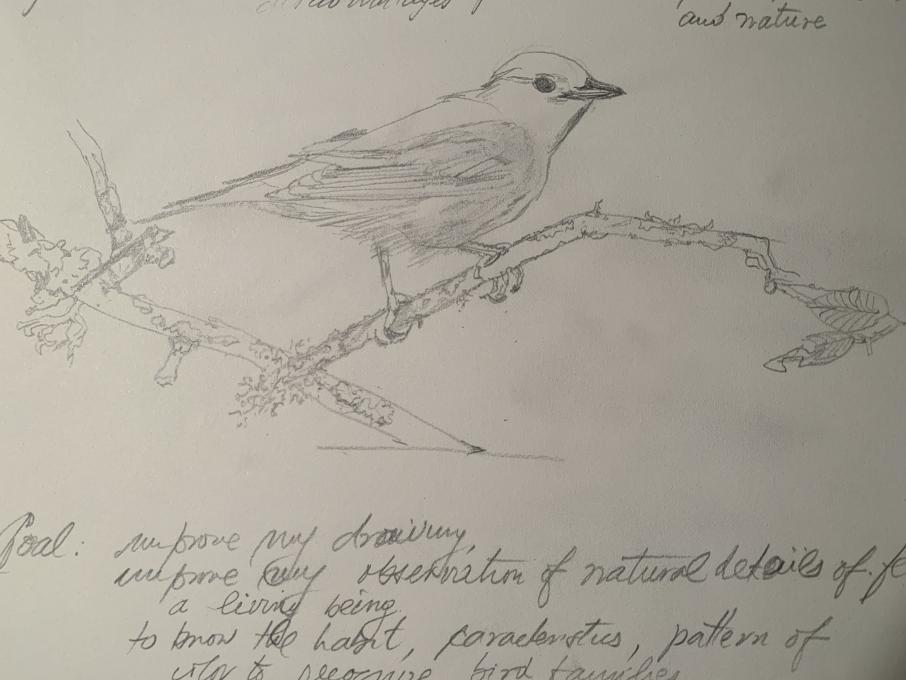

 It is fun to draw from a photo as I can zoom in for detail and the bird doesn’t move.
It is fun to draw from a photo as I can zoom in for detail and the bird doesn’t move. 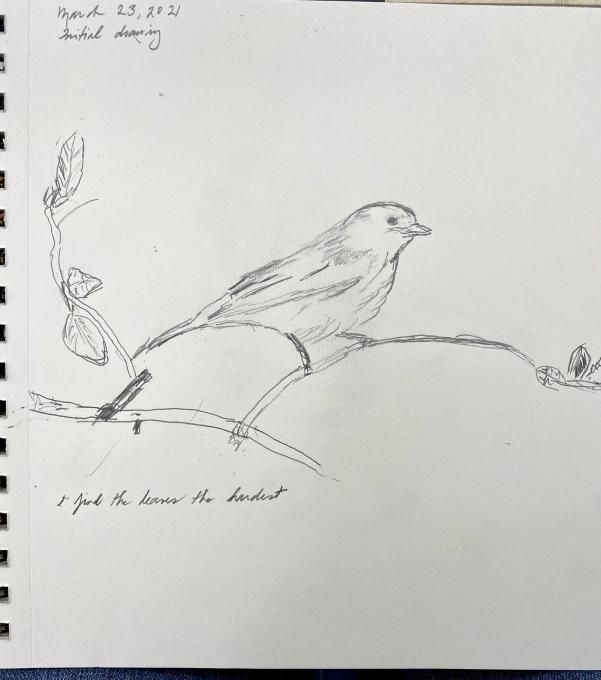

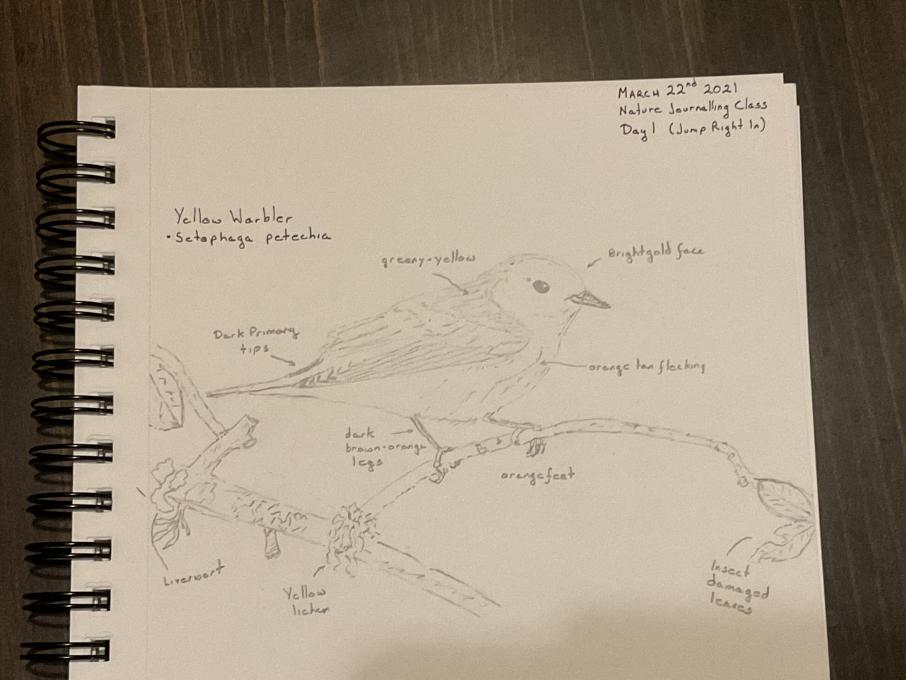
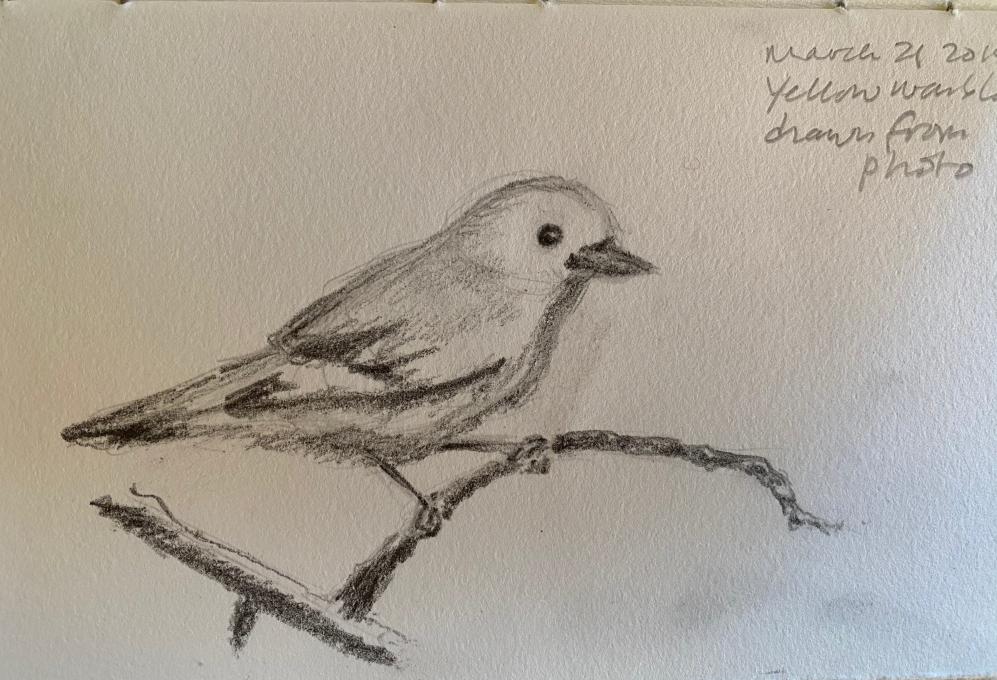
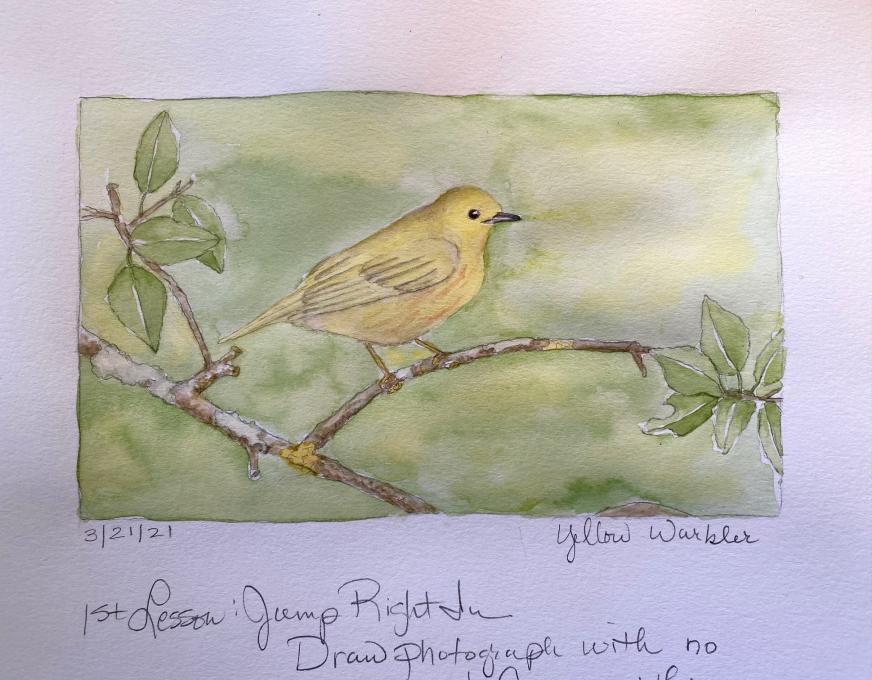
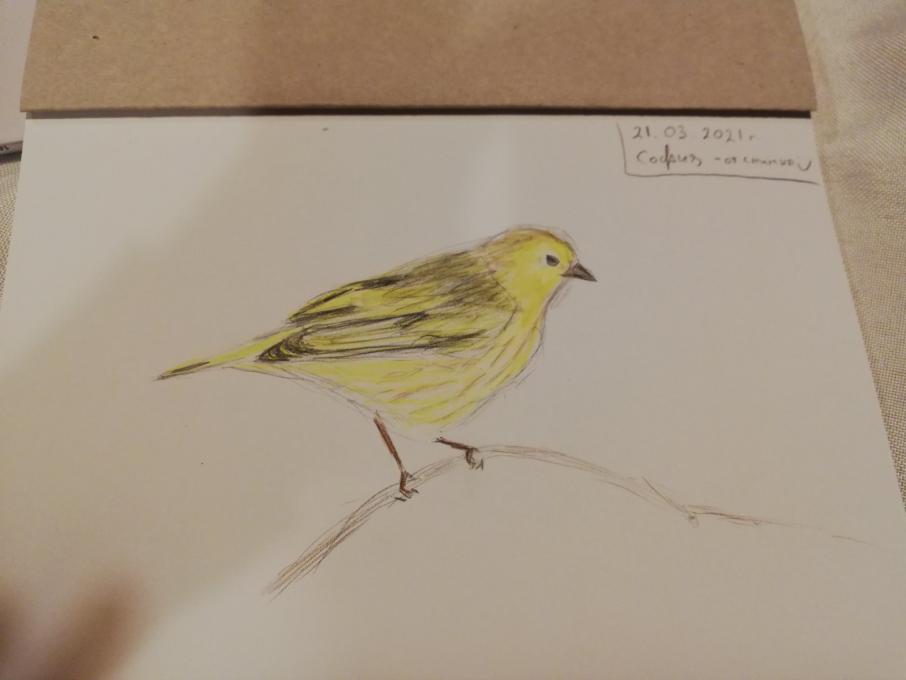

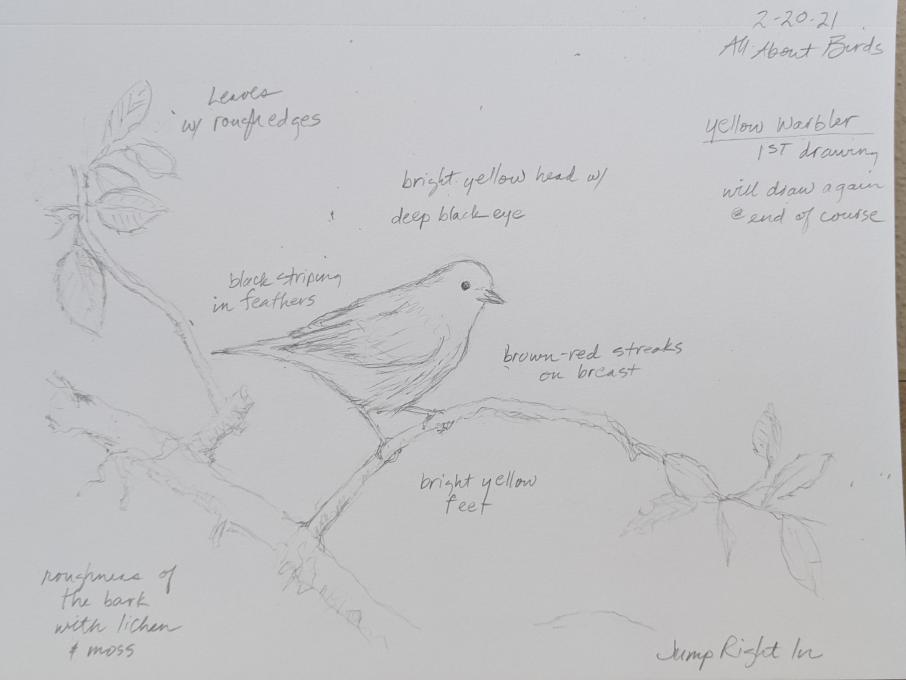
 I think drawings have the advantage of capturing feeling through the eyes and hand of the person drawing - as long as a scientific approach isn't required. Photos have the advantage of capturing actual colors and detail in a clear image. I enjoyed drawing from the photo, because I tend to be slow and might miss a lot of details if I were drawing from nature. I think the overall proportions came easily to me, although there are some areas that are a little off. What was challenging for me was the relationship between the eye and the beak, and capturing the position and definition of the feathers. I might not have noticed all the detail in the branches and feathers if I didn't draw it, and this detail can be important when reporting on your observations in your journal, to differentiate the various birds and their environment.
I think drawings have the advantage of capturing feeling through the eyes and hand of the person drawing - as long as a scientific approach isn't required. Photos have the advantage of capturing actual colors and detail in a clear image. I enjoyed drawing from the photo, because I tend to be slow and might miss a lot of details if I were drawing from nature. I think the overall proportions came easily to me, although there are some areas that are a little off. What was challenging for me was the relationship between the eye and the beak, and capturing the position and definition of the feathers. I might not have noticed all the detail in the branches and feathers if I didn't draw it, and this detail can be important when reporting on your observations in your journal, to differentiate the various birds and their environment. 
 Photos are quick and easy but one's attention to detail really comes into play when you try to draw/paint it. I kept wondering how much detail do I need to add?
Photos are quick and easy but one's attention to detail really comes into play when you try to draw/paint it. I kept wondering how much detail do I need to add? 